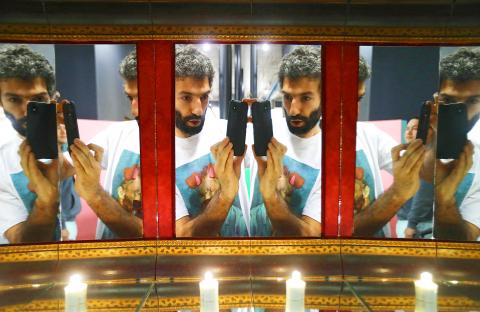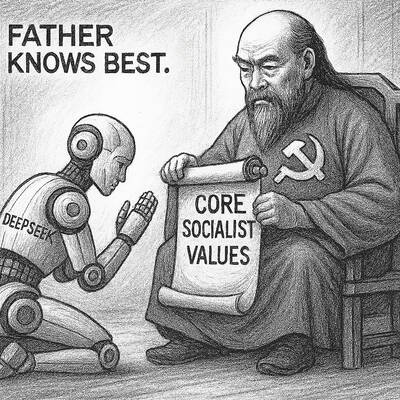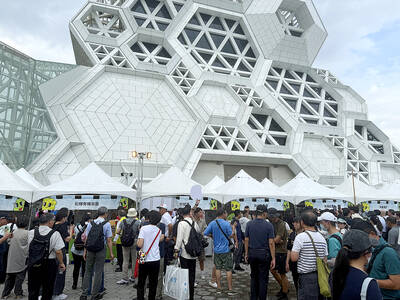There’s an art to taking the perfect selfie — from the angle, to the focus, cropping out that pesky outstretched arm and above all, the smile.
In a celebration of self-portraits in the social media age, Tommy Honton and Tair Mamedov are set to open the Museum of Selfies in Los Angeles this Sunday — an interactive exhibition exploring the history and cultural phenomenon of snapping a photo of yourself.
And for those who think if a moment wasn’t photographed, it might as well have not happened — the good news is that at the Museum of Selfies, selfies are compulsory.

Photo: AFP
Event planner Lori Nguyen, 45, said she doesn’t take selfies very often because “I’m not, like, super young.” But another visitor, Nina Crowe, said she takes “one a day.” Neither missed the chance to snap several at the Museum of Selfies, including at an exhibit mimicking the rooftop of Los Angeles’ tallest building. In reality there’s a backdrop photograph of the “ground below” printed on a small platform, from which sprouts a tube that looks like the building’s antenna complete with a red signaling beacon.
Add a selfie stick, an “I’m afraid of heights” grimace and a click — and the result is very realistic.
The exhibition begins with mirrors, perhaps the most basic kind of selfie. But Honton and Mamedov view the concept as something more than just a simple photo.

Photo: AFP
“The selfies have a surprisingly rich history, and go back as far as people have been making art,” Honton said. “Rembrandt did hundreds of self-portraits, Albrecht Durer five, Van Gogh dozens. Yes, artistic technique and scale is one thing, but in reality, if cell phones and cameras had existed, everyone would have taken them.”
Another selfie museum opened in the Philippines in 2015, but there’s no sign it stayed open. Meanwhile in Glendale, a Los Angeles suburb, the exhibition is just the latest in the city’s stream of quirky museums focusing on everything from rabbits and death to neon and velvet.
‘SELFIE MAGNETs’
The show is full of fun facts about the trend: women take pictures of themselves more than men, for example.
In Sao Paulo, 65.4 percent of selfies are taken by women — in New York, 61.6 percent. In Moscow, the divide is even more extreme, at 82 percent.
There aren’t statistics for Los Angeles, but Ally Bertik admits she is a frequent selfie-snapper.
“It shows off my good side. And I get to show people like ‘hey, this is where I am, maybe you guys should check it out too, this is what I’m doing.’ It’s just a fun way to like spread you know what I’m doing, show people where I’m at,” she said.
Wandering through the museum, guests will be able to pose with Colette Miller’s Angel Wings and a work by Darel Carey, who creates multi-dimensional rooms using plastic tape — a concept the museum describes as a “selfie magnet.”
There are pieces by Brazil’s Rob Vital, German-Canadian Joseph Nowak, Italy’s Michele Durazzi — and a copy of the Russian government’s recommendations for taking a selfie safely, created following several accidents and as many as 12 selfie-related deaths in the country.
Also featured is David Slater’s controversial monkey selfie — which became embroiled in a legal battle over who has the copyright to photos taken by monkeys using his camera.
In a corner, meanwhile, are three statues resembling Michelangelo’s David — painted blue with a pink cell phone — and a Game of Thrones-esque throne created using selfie sticks.
You just “can’t avoid” taking a selfie there, says Mamedov, a Russian actor who arrived in the US four years ago.
The Museum of Selfies will be open in Glendale initially for two months. Its founders are open to extending its LA run and taking the exhibition to other places around the US, if not the world.

Water management is one of the most powerful forces shaping modern Taiwan’s landscapes and politics. Many of Taiwan’s township and county boundaries are defined by watersheds. The current course of the mighty Jhuoshuei River (濁水溪) was largely established by Japanese embankment building during the 1918-1923 period. Taoyuan is dotted with ponds constructed by settlers from China during the Qing period. Countless local civic actions have been driven by opposition to water projects. Last week something like 2,600mm of rain fell on southern Taiwan in seven days, peaking at over 2,800mm in Duona (多納) in Kaohsiung’s Maolin District (茂林), according to

It’s Aug. 8, Father’s Day in Taiwan. I asked a Chinese chatbot a simple question: “How is Father’s Day celebrated in Taiwan and China?” The answer was as ideological as it was unexpected. The AI said Taiwan is “a region” (地區) and “a province of China” (中國的省份). It then adopted the collective pronoun “we” to praise the holiday in the voice of the “Chinese government,” saying Father’s Day aligns with “core socialist values” of the “Chinese nation.” The chatbot was DeepSeek, the fastest growing app ever to reach 100 million users (in seven days!) and one of the world’s most advanced and

The latest edition of the Japan-Taiwan Fruit Festival took place in Kaohsiung on July 26 and 27. During the weekend, the dockside in front of the iconic Music Center was full of food stalls, and a stage welcomed performers. After the French-themed festival earlier in the summer, this is another example of Kaohsiung’s efforts to make the city more international. The event was originally initiated by the Japan-Taiwan Exchange Association in 2022. The goal was “to commemorate [the association’s] 50th anniversary and further strengthen the longstanding friendship between Japan and Taiwan,” says Kaohsiung Director-General of International Affairs Chang Yen-ching (張硯卿). “The first two editions

It was Christmas Eve 2024 and 19-year-old Chloe Cheung was lying in bed at home in Leeds when she found out the Chinese authorities had put a bounty on her head. As she scrolled through Instagram looking at festive songs, a stream of messages from old school friends started coming into her phone. Look at the news, they told her. Media outlets across east Asia were reporting that Cheung, who had just finished her A-levels, had been declared a threat to national security by officials in Hong Kong. There was an offer of HK$1m (NT$3.81 million) to anyone who could assist